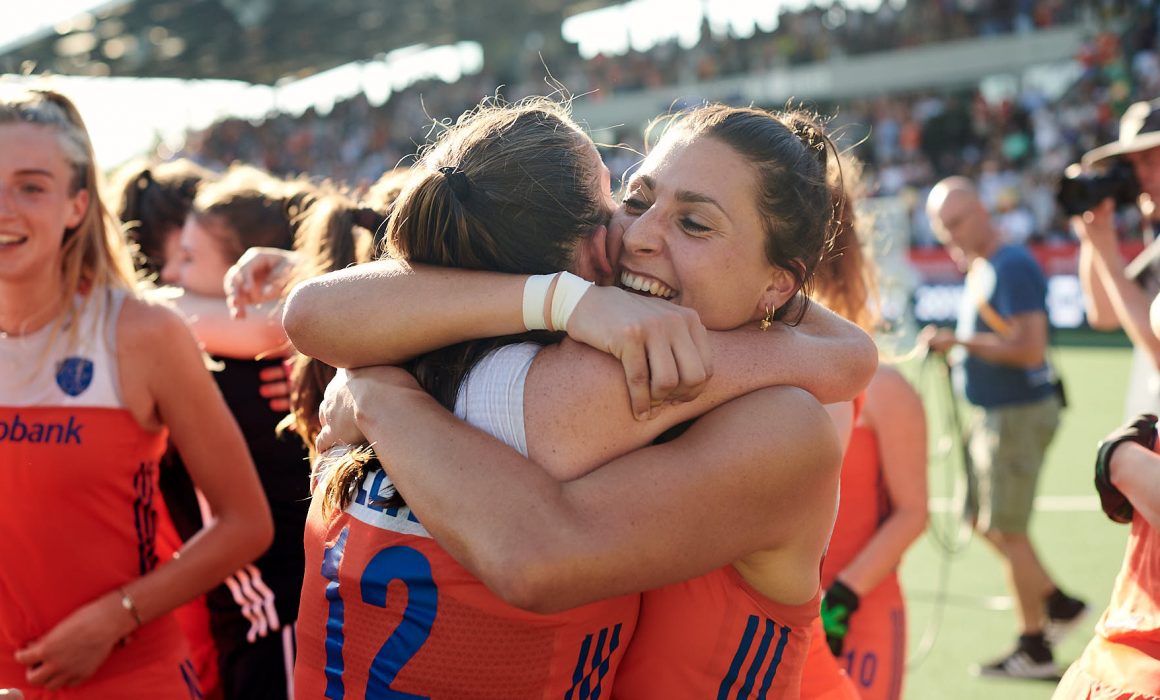Expressing Emotion in Sports Photography
Emotion in sports is a powerful tool for telling a story with photography. Learn all about the types of emotions and how to capture them.
Introduction
Sports is all about emotions. The highs of winning, the lows of losing at the very last second. Exceeding your own and all the fans’ expectations, failing and ending the match or race in disappointment. Emotions tell the story of having goals and meeting them, or failing them. More importantly, emotions show the human side of athletes. They make them more likeable and give depth to their personalities. Seeing genuine emotions in top athletes can turn viewers into fans.
Understanding emotion in sports
How does emotion in sports shows itself? I feel there’s three more or less distinct ways a photographer can capture emotion in sports.
First of all, emotions show up during competition. It could be at the finish line in cycling or after scoring a goal in football. This emotion is there for every spectator to see and for every photographer to capture.
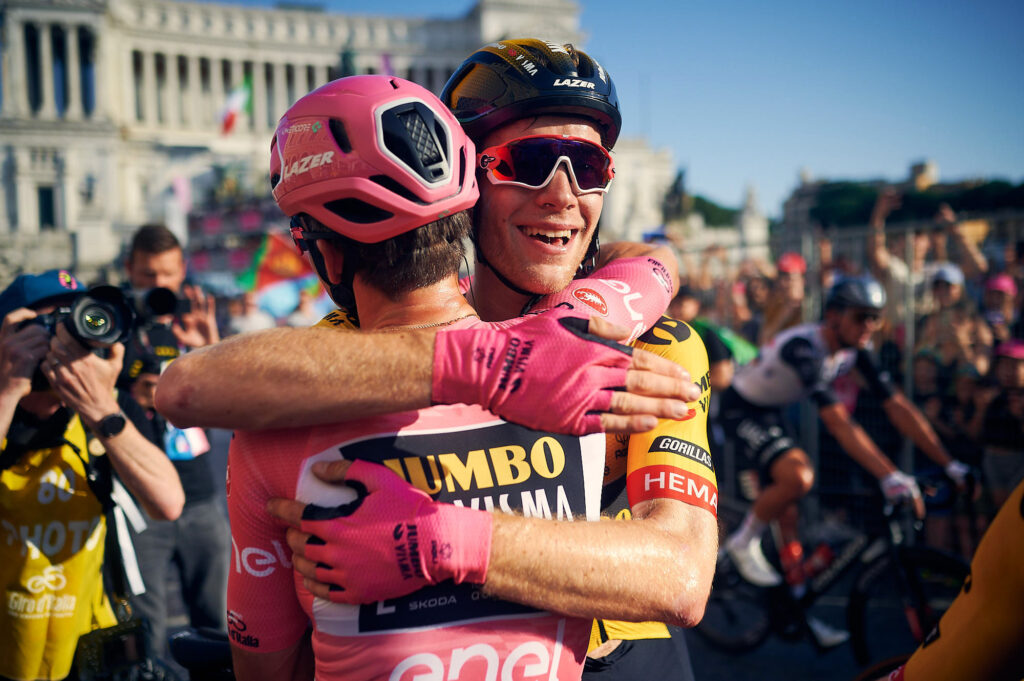
Second, athletes will show emotion off the pitch. This feels a bit more private and maybe shows a bit more of the actual story. Athletes may (rightfully) be a bit more reserved when they know the cameras are watching them. When they’re amongst friends, family and colleagues, they tend to show their emotions a bit more. I’ll call this behind the scenes emotions.
Finally, in a good portrait, emotions of an athlete may also come out. While the photos are staged, throughout the session and if a photographer makes the athlete feel at ease, we may see a bit of their personality and emotions.

Types of emotions in sports
At the risk of stating the obvious, there are two extremes of emotions in sports. Joy, and sadness. I think this may have to do with sports often having such a clear winner and loser. It’s quite black and white, and this often brings out the two extremes.
However, I’ve also seen a wide range of other emotions that can be a bit more subtle. It’s also dependent on the story of the athlete, and knowing their story can help spot and contextualise the emotion. Imagine a young athlete making her debut in a major competition. While she probably won’t win, she’ll feel so excited about even being on the pitch in that game. I imagine there being a radiant look in her face, not of pure joy but of expectations for the future. She’ll be thinking: this is just the start, I’m dreaming of so much more.
Or imagine a cyclist hoping to win a race, but just falling short. Second places are a peculiar thing, and the emotion of the athlete will completely depend on their story. If he had seriously counting on being a contender for the win, second place will feel like a disappointment. Standing next to the winner will feel painful. But imagine a rider getting third after coming back from injury and exceeding everyone’s expectations. This rider may be happier than the one standing one step higher than him.
We see loads of photos showing athletes in utter joy and complete disappointment and disbelief every day. Personally, I’m interested in also looking for the more subtle emotions in sports, as they may tell more of a subtle and interesting story.
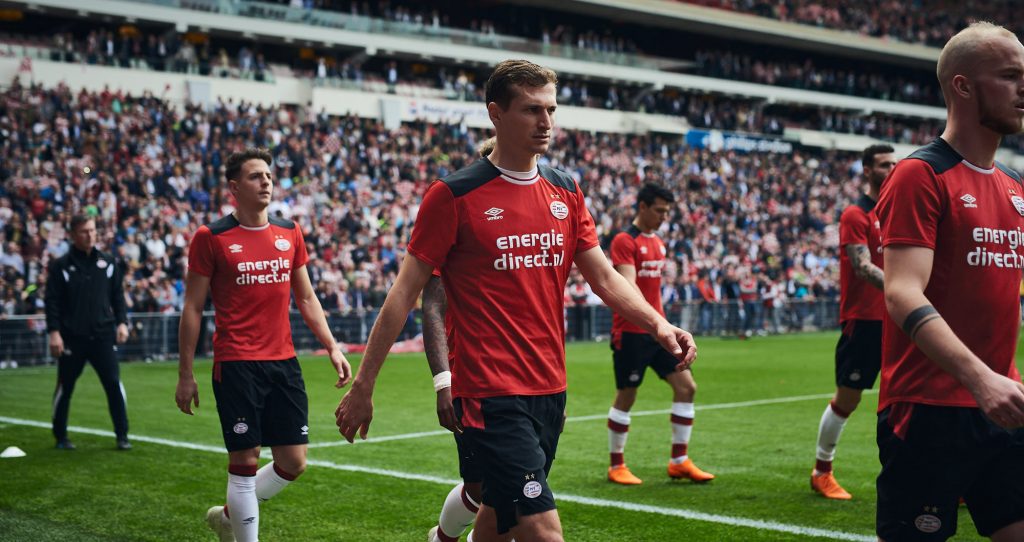
Techniques for capturing emotion in sports photography
There’s a number of techniques and considerations I feel are important for capturing emotion in sports photography. Interestingly, the majority of these have little to do with the technical side of photography.
First and foremost, you need knowledge of the athlete and the sport. It helps so much to know at what point the athlete is in their career, and what their role in the team is. Every athlete has their story, and knowing this helps you value the emotions they show.
Knowing the sport helps you anticipate key moments and get your timing right. Knowing the flow of play in football helps you understand when a goal may be scored or when emotions on the pitch may explode. The challenge in capturing emotion in sports is that the more intense the emotion, the shorter it’ll last.
Another big part of capturing emotions in sports is understanding body language and facial expressions of people. This goes for individual athletes, but it also helps to understand this in a wider human context. Subtle gestures and changes in a face can be incredibly telling.

Finally, there’s the photographic side to capturing emotions. A photographer can choose their composition and viewpoint. Changing these will affect how the subject is framed in the final photo, and how the light and color in the scene are incorporated. Leaving space at one or the other side of a subject can make a world of difference. It can make a subject feel small and weak, or strong and powerful. Standing on one side or the other of a subject can make them look dark and moody, or bright and possibly happy.
Case studies from my own portfolio
Case study 1: the celebration shot
This is quite a classic emotion shot. Your team wins, you celebrate. What makes this shot a bit different is that the guy cheering isn’t on the pitch, but a substitute. I also like how he’s wearing his mouth guard, the prop adding to you understanding the context. For this shot I sat down next to the pitch. I could’ve shot the players in the field as they scored their goal, but then the action would’ve been quite far away. So instead I focused on the bench, allowing me to get close and personal. There was not much anticipating involved for this photo: I simply turned to the bench right as the goal was scored. An emotion like this only lasts a split second though, so you have be quick and have your camera all ready to go.
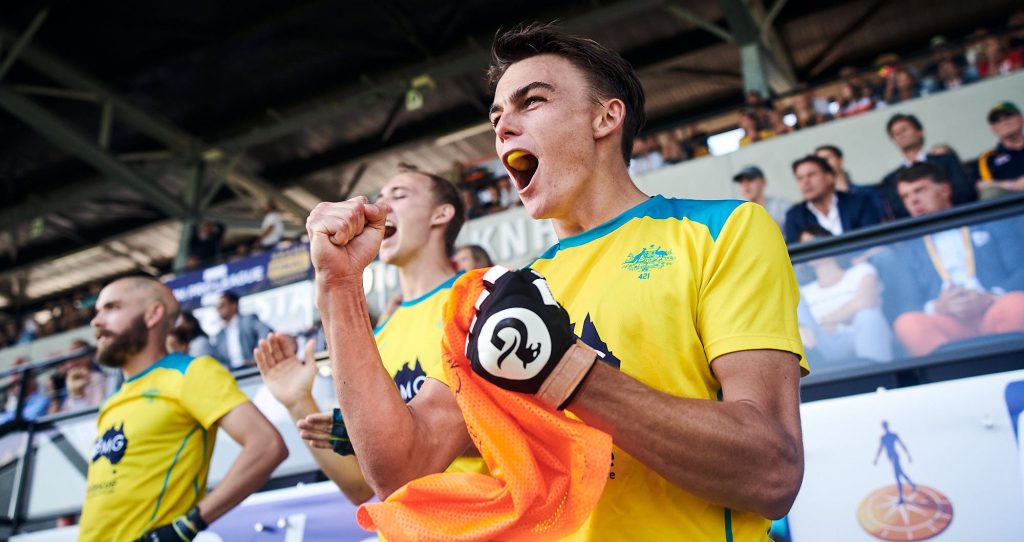
Case study 2: the exhaustion shot
This photo was shot at the infamous Paris-Roubaix race. Riders go across multiple stretches of cobbled roads through French farmlands after finishing in the iconic Roubaix Velodrome. This race is brutal, and just finishing it is an accomplishment of itself. The rider, Romy Kasper, dropped down in the grass after finishing, catching her breath. What I love about this shot is the bright light in her face, juxtaposed with the dark green of the grass. Of course the mud specks add to the story. Her mouth being open to let the air in, and her hands clutching her head are little details that paint a richer picture.
What was quite essential for me in making the photo work, was getting down on the ground. I didn’t want to look down on Romy, as you’d feel less of a connection with her. By kneeling down, I was able to get my camera to the same height as her head, and shoot a more human photo.
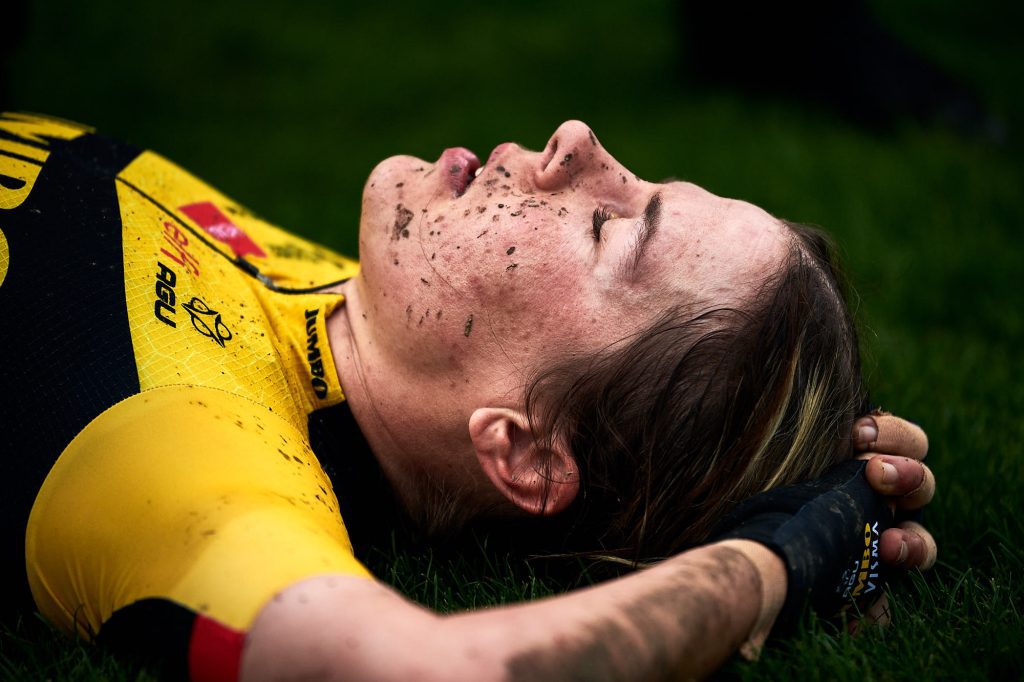
Case study 3: you decide
This photo is probably the most emotional I’ve ever shot. There’s no huge joy or tears, but for me it tells a whole story. This is Jonas Vingegaard with his girlfriend after winning the Tour de France, the biggest bike race in the world. The photo was actually quite uncomplicated to capture, with a simple composition. I also had plenty of time to shoot the photo, as they were sat on the couch for a while. In this particular case, I was more concerned with allowing these two to have a bit of privacy. I shot the images I wanted and then leave them be. It helps that I’m the team photographer and Jonas knows me well, but still I felt I didn’t want to disturb any longer than I had to.
What’s interesting is that I couldn’t quite pinpoint the exact emotion in this photograph. In fact, every person I show this photo is able to name something new. The actual answer can only be given by the two persons in this photo. My best guess? A mix of joy from the win, and relief about all the pressure being gone and being to able to with your family again.
Be sure to also check out the full behind the scenes album from this Tour de France.
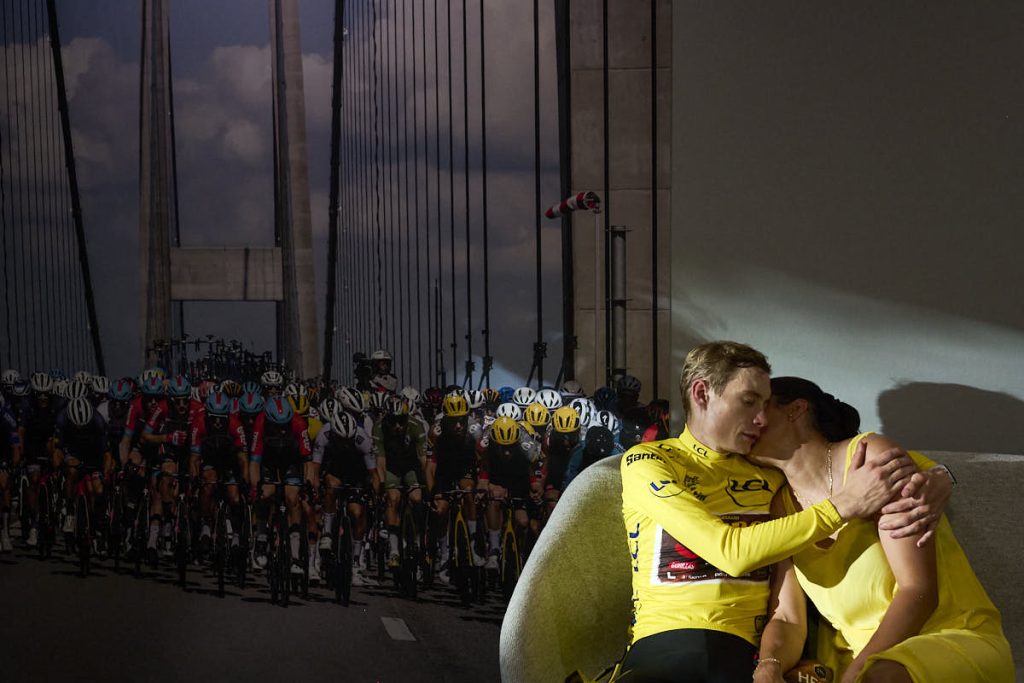
Tips for photographers
One thing photographers can practice, is being patient and waiting for an athlete to show an emotion. Observe the athlete, see how he experiences the game or race, and then anticipate what will happen. When I’m capturing riders after they finished, I try to keep an eye on other riders and family. Inevitable, when riders run into them, an interaction will happen. Be it handshakes, hugs, kisses or fist bumps. These can be a bit cliche but are nice to capture. But just before and after these interactions is where the real gold is. Athletes tend to let their guard down a bit when they have a genuine interaction. This is when you’ll see pure emotions.
A crucial point about capturing emotion is that it’s often gone before you know it. Also, since photography is capturing a single moment and human expression is extremely dynamic, there’s a big chance of missing it. For this reason, I always fire off a large amount of frames and select the absolute best moment afterwards. Having options can really help to make sure you captured the essence of the emotion.
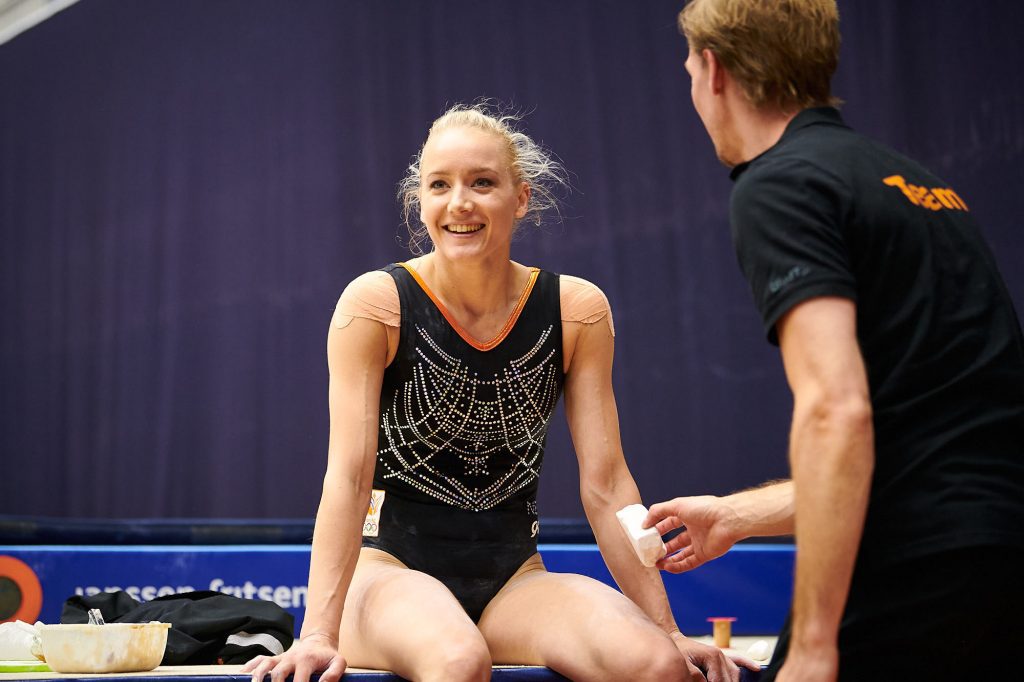
Ethical considerations
When capturing real and raw emotions, it’s important to realise that even though an athlete may be an icon, they’re still a human being. At some point, it may be time to give the athlete privacy. Personally, I stop shooting in case of serious injury. If emotions run really high after disappointment, I try to shoot a few frames and then give the athlete some space. This helps retain a relationship with the athlete, but it’s also a basic form of empathy and respect. There’s a line to walk between authentic emotion and privacy.
Another aspect I feel strongly about, is authenticity and contextual framing. There are multiple angles to these concepts. I think it speaks for itself that outright faking of emotions in photography is very dubious. This could be done using Photoshop for instance but for me is a big no no, as it’s completely disrespectful of the person.
There are more subtle angles to this though. When capturing a series of images in quick succession, there may be a big variety in facial expressions. It’s quite easy to select a frame that may not be representative of the moment. It could be as subtle as an athlete blinking their eyes, and then using the image where they have their eyes closed to suggest the athlete was exhausted. This comes down entirely to the good judgement on the photographer: the photo could be representative of the moment, or completely misrepresent it. Photographers should take their part in this very seriously. Selecting an inappropriate photo could cause an athlete’s reputation serious damage.
Conclusion
Capturing emotion in sports photography is a powerful tool for telling a story. It can help transform athletes into idols and viewers into fans. Both athletes, teams, sponsors and media can benefit from this. With the right techniques and ethical considerations in mind, photographers can have an important part to play in showing the nature of winning and losing, and in telling the story of the athlete.

